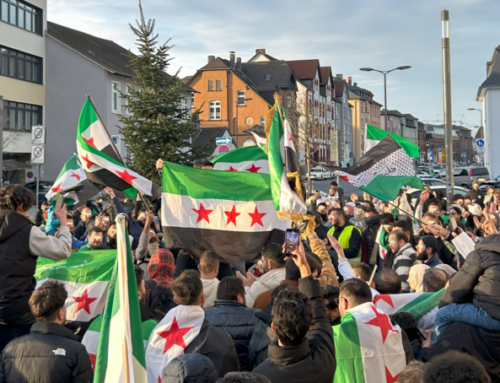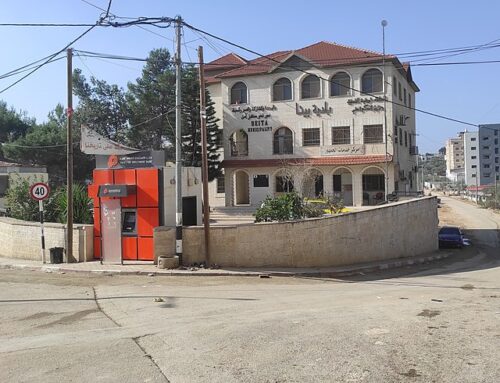 Six months ago, I was stopped on the streets of Pittsburgh by people who barely knew me to relate how horrified they were when they learned about the tunnels that Hamas had built. “Have you seen the tunnel that motorcycles could drive through?” they asked. Usually and particularly if the person speaking with me was of the local Jewish community, he would use the news of the tunnels to further assert that “we cannot make peace with Hamas.” Sometimes, we couldn’t make peace with the “Arabs” as a whole.
Six months ago, I was stopped on the streets of Pittsburgh by people who barely knew me to relate how horrified they were when they learned about the tunnels that Hamas had built. “Have you seen the tunnel that motorcycles could drive through?” they asked. Usually and particularly if the person speaking with me was of the local Jewish community, he would use the news of the tunnels to further assert that “we cannot make peace with Hamas.” Sometimes, we couldn’t make peace with the “Arabs” as a whole.
The reality, of course, is more complex. While Hamas had used everything in its power to raise panic in the Gaza envelop region, the failure to defend the kibbutzim belonged to the IDF. And they are doing it again.
This morning, four months after end of Operation Protective Edge, the IDF announced that it will withdraw its troops from communities bordering the Gaza Strip. This decision is particularly striking because the government has yet to deliver on its promise to build an advanced security fence along the border. This fence, about 60 kilometers (37 miles) long, was planned to run from Kibbutz Zikim south of Ashkelon until Kerem Shalom near the Egyptian border. It would be similar in design to the fence that has been built along the Egyptian border to prevent infiltration into Israel.
People living near Gaza are frustrated and angry. They feel abandoned by their own government. This IDF decision, which comes so close to the election in Israel, suggests that though the Movement for the Future of the Western Negev has raised over 60,000 shekels so far under the banner, “We have no time to lose,” it has still not been successful in making the election about true security.
 |
One of the memes on Facebook: “Fighting for a sense of security. Because we have already given up on real security?” |
While shedding tears and boosting the propaganda machine, which exploited the suffering of the people living a mile or two from Gaza, the Israeli government and the IDF failed to protect them. Two months before the war, an IDF tank accidentally discovered an entrance to a tunnel not far from Kibbutz Nirim. In response, the IDF organized a military exercise and told civilians that it would take security forces 20 minutes to respond to infiltration into the kibbutz. Until then, they were expected to hold their own with a civilian emergency squad. There was no budget for a permanent IDF unit. Nor could the IDF afford to monitor the communities, and not merely surveil the Gaza Strip. A few weeks later the budget for the communal security chiefs was cut. As a friend of mine wrote then: “Did they forget to tell us that we have reached peace?”
When the war started, the IDF sent a class of young soldiers. When one of them was wounded by shrapnel from a mortar shell, the IDF pulled them out immediately. But it never gave orders to evacuate the citizens living in the area. When a missile from Gaza fell near the dining room of Kibbutz Nirim and did not explode, neither the army nor the police disarmed it or took it away. Instead, they fenced it with a white tape and left it there. During the war the army raised a large intelligence balloon over the kibbutz. Hamas soon began targeting it, and the number of missile firings greatly increased. Only after repeated pleas did the IDF agree to remove the balloon from the kibbutz.
Beyond the lack of action to produce a real change in the reality of life in the Gaza envelop region, people living there have reason to feel alienated by the government. In September, for example, the agriculture minister Yair Shamir (Israel Beitenu party and the son of former Israeli Prime Minister Yitzhak Shamir) said during a toast for the New Year that “We will never forgive the residents of Nahal Oz for dancing on the blood of the Gush Katif residents during the disengagement, but they will help them anyway.” Nahal Oz belongs to the Kibbutz Movement, which traditionally supported the Labor Party. But Yair Shamir was the minister responsible for rebuilding the sector most damaged by the war.
Now the residents of the Gaza envelop region are organizing a large demonstration. They demand that the IDF reconsider its decision to pull the soldiers out. But more than that, they want a permanent solution. Their Facebook page reflects daily experience:
 Noa (6 years old) smiles to mom: “Mom, this year in Purim I don’t want to dress up as a princess.”
Noa (6 years old) smiles to mom: “Mom, this year in Purim I don’t want to dress up as a princess.”Mom: “Why?”
Noa: “Because the dress will prevent me from running to a safe zone fast enough.”
They deserve to be a topic of conversation in the Jewish community of Pittsburgh, New York, Boston and Los Angeles — not only when the Hamas is targeting them, but also when their government and the Israeli Defense Forces abandon them.
 Six months ago, I was stopped on the streets of Pittsburgh by people who barely knew me to relate how horrified they were when they learned about the tunnels that Hamas had built. “Have you seen the tunnel that motorcycles could drive through?” they asked. Usually and particularly if the person speaking with me was of the local Jewish community, he would use the news of the tunnels to further assert that “we cannot make peace with Hamas.” Sometimes, we couldn’t make peace with the “Arabs” as a whole.
Six months ago, I was stopped on the streets of Pittsburgh by people who barely knew me to relate how horrified they were when they learned about the tunnels that Hamas had built. “Have you seen the tunnel that motorcycles could drive through?” they asked. Usually and particularly if the person speaking with me was of the local Jewish community, he would use the news of the tunnels to further assert that “we cannot make peace with Hamas.” Sometimes, we couldn’t make peace with the “Arabs” as a whole.







They appear to be the buffer zone. If we assume the government would sacrifice their own people to advance their ultimate agenda and allow for critical analysis, a disturbing picture emerges. Removal of security forces encourages attack or allows for greater impact in the case of an attack. As well, either encouraging attacks from or paying members from pal opposition to perpetrate attacks IS the only justification the govt can use to maintain a state of emergency which then justifies skirting or disregarding human rights laws or occupier responsibility – and allows for the type of extreme retribution against pal people and demolition of more properties in pal areas.
Please note, this is not intended to disregard unprovoked attacks and the resultant suffering.